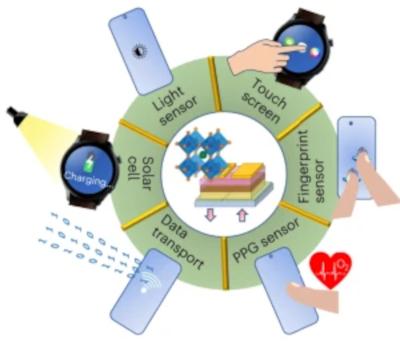Researchers at Linköping University, Nanjing University and NanjingTech have developed a multifunctional display that uses photo-responsive metal halide perovskite LEDs as pixels. The perovskite LED display can be simultaneously used as a touch screen, ambient light sensor and image sensor (including for fingerprint drawing) without integrating any additional sensors. The light-to-electricity conversion efficiency of the pixels also allow the display to act as a photovoltaic device that can charge the equipment.
Illustration of functions realized by the multifunctional display. Image from Nature Electronics
This is a step forward compared to current display screens, which are typically only used for information display, but can have a range of different sensors integrated into them for functions such as touch control, ambient light sensing and fingerprint sensing. According to the team, photo-responsive light-emitting diodes (LEDs), which can display information and respond to light excitation, could be used to develop future ultra-thin and large screen-to-body ratio screens. However, photo-response is difficult to achieve with conventional display technologies.
The team has shown that there is great potential for a new generation of digital displays where new advanced features can be created. Future work should focus on improving the technology and turning it into a commercially viable product.
To become a multi-function display that detects touch, fingerprints or changing lighting conditions, a variety of sensors are currently required, that are layered on top of or around the display. The researchers have now developed a completely new type of display where all sensor functions are also found in the display's LEDs without the need of any additional sensors. The LEDs are made of a perovskites, whose excellent ability of light absorption and emission prove to be the key that enables the newly developed screen.
In addition to the screen reacting to touch, light, fingerprints and the user's pulse, the device can also be charged through the screen thanks to the perovskites' ability to also act as solar cells.
For a screen to display all colors, there needs to be LEDs in three colors - red, green and blue - that emit light with different intensities and thus produce thousands of different colors. The researchers have developed screens with perovskite LEDs in all three colors, paving the way for a screen that can display all colors within the visible light spectrum.
But there are still many challenges to be solved before the screen can be put to commercial use. Issues such as lifetime ans stability will need to be addressed in order to put this new technology to use.




